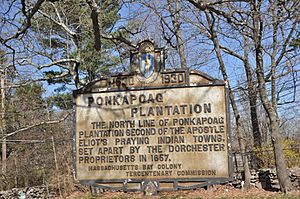Ponkapoag facts for kids
Ponkapoag (pronounced PONG-kuh-pog) is a special place in the history of Massachusetts. It was a "praying town" for Native Americans in the late 1600s. These towns were set up for Native people who chose to follow Christianity.
Ponkapoag was created in 1657. This was a time when settlers from Britain were building new communities along the Atlantic Ocean coast of the United States. The name Ponkapoag first referred to the winter home of a group of Massachusett people. They spent their summers near the Neponset River.
Today, most of the area known as Ponkapoag is part of the town of Canton, Massachusetts. The name comes from a nearby pond. Ponkapoag means "shallow pond" or "a spring that bubbles from red soil."
A Special Place in History
Ponkapoag Plantation was started in 1657. It was a large area, about 6,000 acres, taken from the town of Dorchester. It was the second Christianized Native settlement, or "Praying Town," in Massachusetts. The first one was Natick, which began in 1651.
Who Lived There?
In 1654, some members of the Nemasket Tribe moved to Ponkapoag. They were among the first Native Americans to be relocated there by missionaries. Missionaries were people who tried to teach others about Christianity.
Important Leaders
From 1657 until he passed away around 1670, a man named Quashaamit (also known as William) was a teaching minister in Ponkapoag. He helped lead the community. Quashaamit also sold large areas of land in places like Mendon, Milford, Braintree (now Quincy), and North Smithfield.
Ponkapoag Today
The name Ponkapoag is still important today. Two groups that celebrate Native American culture are named after it: the Massachusett Tribe at Ponkapoag and the Praying Indians of Natick and Ponkapoag. These groups help keep the history and traditions of the Native people alive.


